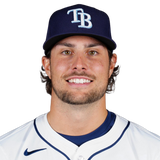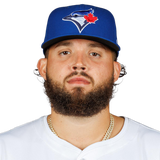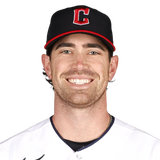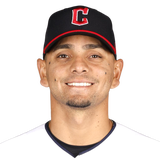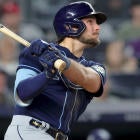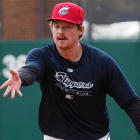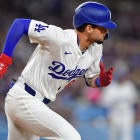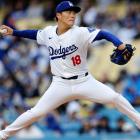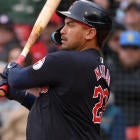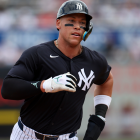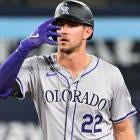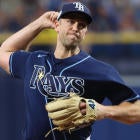
Another month in, it's once again time to take inventory of the risers and fallers for Dynasty leagues.
Remember that the evaluations here are slightly different from redraft leagues. The focus is on the long term, which requires a more deliberate approach. One wrong move could reverberate for years to come.
Case in point: many of the risers in this edition were top prospects not so long ago. Dynasty leaguers who waited out the early struggles are reaping the benefits now. Dynasty leaguers who bailed for a more immediate payoff are missing out.
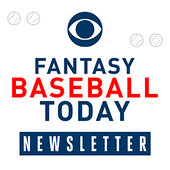
Fantasy Baseball Today Newsletter
Your Cheat Code To Fantasy Baseball
You're destined to gain an edge over your friends with advice from the award-winning FBT crew.
Thanks for signing up!
Keep an eye on your inbox.
Sorry!
There was an error processing your subscription.
Though a four-time top-100 prospect dating back to 2017, Mitch Keller was lost in the wilderness for a while there, searching for the right pitch mix to bring out his potential. He's settled on a cornucopia of six pitches that are all pretty decent and can be emphasized or de-emphasized as needed. It's an unconventional path to success but one that's worked for Joe Musgrove and Yu Darvish, to name a couple, and it seems to be working for Keller, too, who's been a top-10 pitcher so far this year. As good as his ERA is, his xERA, FIP and xFIP are even better, and his K-BB% ranks behind only Spencer Strider and Kevin Gausman. Just like that, Keller has gone from being a Fantasy punchline to a Dynasty centerpiece at a time when good pitching is hard to find.
| ||||||
Just to cut us all some slack, I'll point out that certain institutional disadvantages made Joshua Lowe's disappointing rookie season seem more definitive than it's turned out to be. He was a left-handed hitter for a Rays team that's as committed to a particular hitter as you are to a particular shopping cart -- one wobbly wheel, and it's on to the next one. Turns out, though, that the athletic profile that got so many Fantasy pundits excited last year is indeed shining through this year. A 50 percent reduction in strikeouts helps. We could nitpick Lowe's middling average exit velocity, but the bottom line is his xBA and xSLG are both 95th percentile. That's enough to convince me he's legit.
| ||||||
Nolan Gorman continues the theme of prospects we quit on too early, which perhaps serves as a lesson to Dynasty leaguers. The instant successes we saw throughout the 2010s were more the exception than the rule, historically speaking, so we should probably give graduating prospects a year or two to find their footing. To be fair, it didn't seem like the Cardinals were counting on Gorman seizing an everyday job either, which is why Jordan Walker broke camp with the team. Also to be fair, that's far from the only thing the Cardinals have bungled this year. Gorman's power has been as impactful as advertised, his plate discipline is much improved, and he's even getting starts against lefties now. Picking up third base eligibility in addition to second only adds to the appeal.
| ||||||
Matt McLain hasn't gotten enough at-bats yet to shed the "prospect" label, but since it's evident he's here to say, I've opted not to leave him for the prospect portion of this article. His Dynasty stock was already soaring prior to his mid-May promotion thanks to his .348 batting average, 12 homers, 10 steals and 1.184 OPS at Triple-A Louisville. Though he was a first-round pick in 2021, a disappointing showing at Double-A last year kept him out of the top-100 discussion this winter. He's once again looking like a building block, though, whether his future is ultimately at shortstop or second base. So far in the big leagues, McLain has excelled at spraying the ball all over the field, but his power should play up at Great American Ballpark. He also has speed to spare.
| ||||||
There were hints of Bailey Ober's Fantasy potential prior to this season, but seeing as he still hadn't secured a rotation spot by age 27, you couldn't treat him as a real building block. Even this year, it took a few injuries to open the door, but at long last, the Twins finally seem committed to starting him every fifth day. And wouldn't you know it, he's been just as good as in all his previous chances. His game is geared toward keeping men off base. His extreme fly-ball rate keeps hits to a minimum, and his precision pitching keeps walks to the minimum. You'd think all the fly balls would make Ober vulnerable to home runs, which hasn't been the case yet, but even if it comes to pass, they'll mostly be of the solo variety.
|
Prospects who've gained the most value
A.J. Smith-Shawver, SP, Braves
A+/AA/AAA: 2-1, 1.09 ERA, 0.94 WHIP, 33 IP, 12 BB, 45 K
Majors: 2 1/3 IP, 0 H, 0 ER, 1 BB, 3 K
The 20-year-old's stock has risen so much that he suddenly finds himself in the big leagues, having climbed all the way from High-A in about a month's time. Next, Smith-Shawver is expected to step into the starting rotation after throwing 2 1/3 scoreless innings in his debut Sunday. Things have escalated so quickly that it's hard to know what we're working with here, but the Braves have had a remarkably low miss rate on prospects recently, which should inspire confidence. Smith-Shawver didn't start pitching until his senior year of high school and was still so new to it last year that he was walking everyone in sight, but with improved control this year, his fastball/slider combo looks pretty devastating.
Ronny Mauricio, SS, Mets
AAA: .333 BA (234 AB), 8 HR, 9 SB, .923 OPS, 11 BB, 41 K
Mauricio has long been on the fringes of top-100 lists as a toolsy prospect with intriguing power potential, but as recently as this year, Baseball America had him with only a 40-grade hit tool. How different things look today. The 22-year-old has maintained a batting average over .330 basically from the drop, combining premium exit velocities with newfound contact skills, and of course the over-the-fence potential remains. He could stand to have more patience at the plate, but it won't stop him from stepping into the Mets lineup soon.
Emmet Sheehan, SP, Dodgers
AA: 4-1, 1.64 ERA, 0.79 WHIP, 49 1/3 IP, 19 BB, 83 K
The Dodgers appear to have struck gold yet again, this time with their sixth-round pick from two years ago. The 23-year-old has been an unstoppable force at Double-A. The 1.64 ERA and 15.1 K/9 probably tell you all you need to know, but I'll also point out that Sheehan hasn't allowed more than three hits in any of his 11 starts and boasts a Spencer Strider-like 20 percent swinging-strike rate. In fact, his best weapon is much like Strider's, a high-90s fastball with the sort of vertical approach angle that creates the illusion of "rising" on its way to the plate.
Heston Kjerstad, OF, Orioles
AA: .310 BA (184 AB), 11 HR, 3 SB, .960 OPS, 15 BB, 31 K
Kjerstad was the second overall pick in the 2020 draft, going in between Spencer Torkelson and Max Meyer, which you might think gives his stock little room to improve. But he was a divisive pick in the first place given his unconventional swing and questionable hitting profile (beyond offering raw power), and his stock became even more strained when he was diagnosed with myocarditis and missed his first full professional season. He was mostly good in his debut last year but has taken things to another level this year at Double-A Bowie. The power has been as advertised, but most impressive is the 15.0 percent strikeout rate, which should clear up question about his hit tool.
Ben Brown, SP, Cubs
AA/AAA: 4-3, 2.63 ERA, 1.19 WHIP, 48 IP, 23 BB, 70 K
A 6-foot-6 righty who came over from the Phillies in the David Robertson trade last July, Brown has emerged as a likely rotation piece for the Cubs, equipped with two knee-buckling breaking balls and a mid-90s fastball that plays up because of his long reach. His stock reached its highest point in mid-May, when he had just moved up to Triple-A Iowa and was darn near pitching a shutout for the entire season, but he's had some trouble finding the strike zone since the move. He does already have two double digit-strikeout efforts at Iowa, though, and continues to trend upward overall.
I'd be remiss not to point out that Alek Manoah is 25 and was near flawless in his first two big-league seasons. Those are reasons enough to hang on in a Dynasty league if the choices are limited to drop or hold. But they aren't, are they? In every way a pitcher can struggle, Manoah has, to the point of rendering him unusable. The numbers keep getting worse, and there's no reason for optimism in the underlying data. The remaining hope is that whatever broke for him, be it his delivery or approach or whatever, can be fixed just as abruptly, like flipping on a light switch. It's hardly unprecedented, but there's no timetable for that sort of thing either. It's either going to happen one day or it won't. There is a buy opportunity here if you're playing for next year, but the discount would need to be steep.
| ||||||
For most of this season, Shane Bieber's ERA hovered between 2.50 and 3.00, which may have lulled you into a false sense of security. But the warning signs were there. Truth be told, they were there last year, too, when his fastball velocity plummeted coming off shoulder issues. He succeeded in spite of it because his breaking balls were other-worldly, but they've since come down to earth while his fastball velocity still hasn't returned. The result is that he's no longer missing bats. Between that and his longstanding penchant for hard contact, the slippage is apparent to all now. His numbers after his latest start are positively pedestrian, and there's a chance they'll get even worse.
| ||||||
The biggest issue is that the Blue Jays just don't seem all that committed to playing Alejandro Kirk. It's clear they never valued him much as a catcher, and this year, they have options like Brandon Belt that they prefer at DH. Even now with Danny Jansen sidelined by a groin strain, Kirk isn't getting full-time at-bats. Granted, he's not doing himself any favors. The thump has gone missing from his bat, which is evident not just from his lack of homers but also his exit velocity readings. It's fair, then, to ask why the Blue Jays would even want to give him more at-bats, but if they really believed in the bat, they'd let Kirk work through his struggles. Since they're treating him more like a role player rather than a building block, we should probably be doing the same in Dynasty.
| ||||||
As a 30-year-old, Teoscar Hernandez didn't enter the year with as much Dynasty value as redraft value, but you wouldn't have been wrong to assume he still had 3-4 good years left. He had validated his breakthrough 2020 twice over, and though he was going from Toronto to a worse hitting environment in Seattle, his quality of contact was such that it didn't raise too many alarms. And indeed, the issue hasn't been the quality of the contact but the amount of it. He's flailing at everything, entering play Tuesday with career-worst strikeout and walk rates. Of particular concern is his reduced production against fastballs, which is one of the earliest indicators of decline (hello, Jose Abreu). It's reasonably likely that Hernandez still puts together a good season, and I haven't advised any redraft players to drop him. But for Dynasty purposes, you can't be thinking he has 3-4 good years left still.
| ||||||
The good news is that Andres Gimenez is only 24 and runs fast. The bad news is that his 2022 production may have been too good to be true. There was some evidence of this even as it was happening. He well outperformed his .257 xBA and .400 xSLG, and in fact, this year's numbers are more in line with those. Gimenez just doesn't have much thump in his bat. His average exit velocity this year is in the 1st percentile, which is to say about as bad as it gets. Again, he has some foundational tools to work with -- some athleticism, some bat-to-ball skills -- so even though a 2022 repeat may be out of reach, he could grow into more than he currently is. But the idea that you've found your second baseman for the long haul is one that you'll want to reconsider.
|










